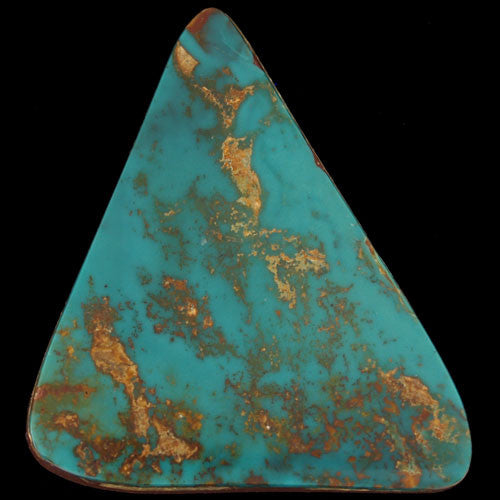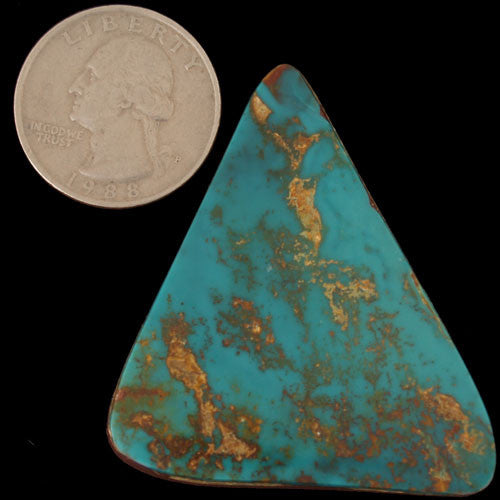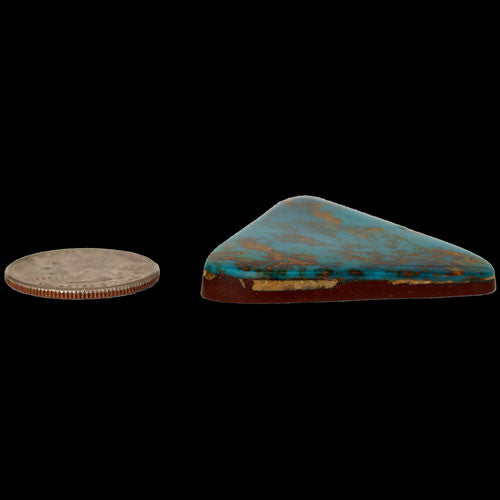




82 cts Natural Gem Grade Blue Gem Turquoise Cabochon (#20)
$3,280.00
You see before you an 82-carat cabochon of super-fine, high-grade, natural Blue Gem turquoise from Battle Mountain, Nevada, USA. This stone has so much character it seems unreal. The bright and beautiful blue/green color is simply amazing. The Blue Gem turquoise mine once produced some of the best turquoise ever unearthed. This stone was mined and cut in the mid 1970s, the heyday of Blue Gem production. Beauty, rarity and durability, this stone has all that and more.
Blue Gem Turquoise
Blue Gem turquoise occurs in argillized quartz monzonite cut by two limonite-stained sheer zones, one trending N 35 o W and dipping 75 o NE, the other trending N, 25 o E and dipping 55 o NW. An extensive breccia zone about 10 feet wide is developed between the two bounding sheers. Exceptionally good quality turquoise forms veins up to three-quarters of an inch thick along the shears. Pyrite-bearing quartz veins are closely associated with the turquoise.
The Blue Gem mine was at one time located deep underground, accessed by tunnels as deep as 800 feet. This is of interest because the Blue Gem Mine and the Bisbee Mine in Arizona are the only two mines (of which we are aware) that turquoise was found that deep in the earth. The Blue Gem mine was once developed in extensive underground workings and open stoops. An audit several hundred feet long on the main structure connected to numerous shorter tunnels and several open stoops. Directly above the main audit was a glory hole some 100 feet long.
Duke Goff first noted the Blue Gem deposit in 1934. It was subsequently leased from the Copper Canyon Mining Co. by the American Gem Co. of San Gabriel, CA., owned by Doc Wilson and his sons, Del and William. The company operated the property until 1941 when the outbreak of the war caused a shortage of experienced miners. Both Del and William Wilson were called into the Army for the duration of the war, and this compelled the closing of the mine. Consequently, the lease was allowed to lapse and work was abandoned. In 1950 Lee Hand and Alvin Layton of Battle Mountain leased the mine.
Production of turquoise at the Blue Gem lease in the early days of the operation was enormous. Although there is no exact information, it is reported that the output amounted to nearly
$1 million in rough turquoise. The mine is still active, although Duval Corp is currently in the center of a major copper deposit developing it.
Pyrite in Blue Gem is unusual to see but not unheard of. Very little large material ever came out of Blue Gem, the majority found was small 1-mm "bleeder" veins and tiny nuggets which was perfect for Zuni inlay and fine needlepoint, petit-point and snake-eyes jewelry. Blue Gem turquoise was very popular in the late 1930's and 40's and was commonly used in the Fred Harvey "tourist jewelry" that is so collectable today. Blue Gem turquoise is extremely hard and stands up well to the test of time.
Blue Gem turquoise is a rare, valuable and historic American treasure. Quality Blue Gem Turquoise has been gifted with a wide range and variety of color. Because Blue Gem turquoise is very hard, a high polish is associated with this stone, and unlike most turquoise, won't easily change color. This turquoise has a unique character and many different looks all of which are striking, full of wonder and pleasing to the eye.
Production of the mine started about 1934 and continued into the 1970's. Blue Gem Turquoise is still some of the finest turquoise ever found, and unlike most turquoise mines, (in which the majority mined is chalky and only usable if stabilized) most of the turquoise found there was of gem-quality. Today the Blue Gem mine is not viable; it sits in the middle of a huge mining operation. The emphasis is on precious metals and the extraction of turquoise is considered more of a hindrance in the mining process rather than an asset. Even the ever-popular "Dump Diving" for turquoise through the overburden is not tolerated due to the very real danger of becoming buried in a slide. Insurance factors, equipment hazards, high explosives and safety issues along with a lack of interest from the mining company keep Blue Gem turquoise unavailable to the world, at least for now.
Related legends:
Precious Stones Turquoise; Precious stones have symbolic implications. For example, turquoise if a "collective term for all the precious stones, wealth, or mixed offerings. Good fortune is attributed to this stone." Both white shell and turquoise are emphasized in Kinaalda? More about this legend
